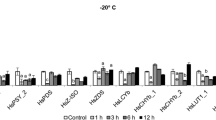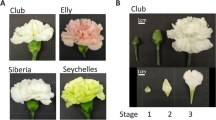Abstract
In higher plants, there are many studies on carotenoid biosynthetic pathways and their relevant genes. On the other hand, few researches exist on carotenoid biosynthesis in early-land plants containing liverworts, mosses, and ferns. Thus, the evolutionary history of carotenoid biosynthesis genes in land plants has remained unclear. A liverwort Marchantia polymorpha is thought to be one of the first land plants, since this plant remains a primitive figure. Moreover, this liverwort is regarded as the model plant of bryophytes due to several reasons. In this chapter, we review carotenoid biosynthesis in liverworts and discuss the functional evolution and evolutionary history of carotenogenic genes in land plants.
Access provided by Autonomous University of Puebla. Download chapter PDF
Similar content being viewed by others
Keywords
1 Introduction
Bryophytes are non-vascular plants, which contain three lineages, phylum Bryophyta (mosses), phylum Marchantiophyta (liverworts), and phylum Anthocerophyta (hornworts). They have an obvious gametophyte stage. Liverworts, observed ubiquitously, show the dominant gametophyte generation, which retains leaf-like structures (thalli) and root-like structures (rhizoids). Liverworts can be propagated by both asexual and sexual growth. A liverwort Marchantia polymorpha L. belongs to the class Marchantiopsida and is commonly known as “liverwort,” which is unisexual with male and female sexual organs formed on distinct plants. This liverwort can be propagated not only asexually by gemmae but also sexually by spores. M. polymorpha remains a primitive figure, which is a very interesting feature from the viewpoint of plant evolution. Especially, this liverwort is highlighted as one of the first land plants to elucidate the origin and evolution of plants on landscape. Thus, M. polymorpha has been widely studied in its physiology and genetics. Recently, M. polymorpha genome became available, which should make genomic comparisons feasible with wide phylogenetic levels (Bowman 2016). Moreover, genetic techniques in the liverwort, being developed, allow this plant to become the model plant of bryophytes (Ishizaki et al. 2008; Ishizaki et al. 2013). We noted the carotenoid biosynthesis genes of M. polymorpha. In this chapter, we review carotenoid biosynthesis in liverworts and discuss the functional evolution and evolutionary history of carotenogenic genes in land plants.
2 Carotenoid Profile of Liverworts
Carotenoid compositions have widely been examined in higher plants. It is striking that all the plant green leaves examined contain the same major carotenoids, i.e., β-carotene, lutein, violaxanthin, and neoxanthin (Goodwin and Britton 1988). α-Carotene, β-cryptoxanthin, zeaxanthin, antheraxanthin, and lutein-5,6-epoxide are commonly also present as minor carotenoid components (Goodwin and Britton 1988). Carotenoid profiles in the flowers are distinctive according to higher-plant species (see Chaps. 7 and 8). On the other hand, a few examinations have been conducted on the carotenoid profile of bryophytes. Czeczuga (1980) showed that the same carotenoids as those in higher-plant leaves, such as β-carotene, lutein, and zeaxanthin, were found in bryophytes. In addition, some ketocarotenoids, such as astaxanthin, were also detected in the liverwort gametophyte by TLC (Czeczuga 1980). We examined carotenoid content and composition in the male and female thalli of M. polymorpha (Takemura et al. 2014). Consequently, no significant differences were observed between the male and female. Lutein and β-carotene were dominant carotenoids, and α-carotene, lutein-5,6-epoxide, zeaxanthin, antheraxanthin, violaxanthin, and 9′-cis-neoxanthin were also found in the thalli. Their carotenoid compositions were similar to those in the leaves of higher plants (Fraser and Bramley 2004; Demmig-Adams et al. 1996; Goodwin and Britton 1988). However, no ketocarotenoids were detected in the liverwort thalli. This discrepancy may be due to the different methods of extraction and analysis or different liverwort materials. It would be required to investigate the carotenoid profiles of sexual organs and sporophytes in detail.
3 Carotenoid Biosynthesis Genes of the Liverwort
The presence of the leaf-type carotenoids in bryophytes suggested that these organisms may possess the same carotenoid biosynthetic pathway as that of higher plants. So far, few researches existed on the carotenoid biosynthesis genes of bryophytes. Recently, we analyzed the carotenoid biosynthesis genes in the liverwort (Takemura et al. 2014, 2015a). According to dry analysis of the M. polymorpha genome sequence, liverwort genes proved to be single copy, while higher plants often possess redundant carotenoid biosynthesis genes (Takemura et al. 2015b). For example, Arabidopsis, tomato, maize, and rice carry 2, 2, 6, and 3 BHY (β-carotene hydroxylase) genes, respectively, although two among the six maize BHYs are pseudogenes (Vallabhaneni et al. 2009). In addition, tomato has two PSY and two LCYb genes. A moss Physcomitrella patens was found to be a paleopolyploid, and many of the genes proved to be duplicated (Rensing et al. 2007). In the P. patens genome, the carotenoid biosynthesis genes are highly redundant. Its metabolic genes have been thought to be maintained in excess after the duplication event. In contrast, there are few polyploids in most liverworts and hornworts (Rensing et al. 2007). Therefore, M. polymorpha is regarded as a suitable organism material for study about plant evolution.
We analyzed the functions of the M. polymorpha carotenoid biosynthesis genes using the E. coli expression system (Misawa et al. 1995). E. coli cannot produce carotenoids but produce FPP (farnesyl diphosphate).Thus, by introducing carotenoid biosynthesis genes that start from GGPP (geranylgeranyl diphosphate) synthase gene, engineered E. coli can produce carotenoids, such as phytoene, lycopene, and β-carotene. The functions of the MpLCYb, MpLCYe, MpBHY, MpCYP97A, and MpCYP97C genes were elucidated so far (Takemura et al. 2014, 2015a). The results indicated that MpLCYb and MpLCYe show enzyme activities as lycopene β- and ε-cyclase, respectively, as anticipated. Interestingly, MpBHY was able to hydroxylate not only the β-rings of β-carotene but also the β-ring of α-carotene, and MpCYP97A showed no enzymatic activity to both β-carotene and α-carotene. It was strikingly elucidated that MpBHY and MpCYP97C function as β-ring and ε-ring hydroxylase of α-carotene, respectively, to produce lutein. In higher plants, CYP97C functions mainly along with CYP97A, not with BHY (Kim and DellaPenna 2006; Tian et al. 2003; Quinlan et al. 2012). In the liverwort, CYP97A is unlikely to be involved in carotenoid biosynthesis and may function in a different pathway.
Other M. polymorpha genes for carotenoid biosynthesis are under investigation. Our preliminary data indicated that most of them are functional (in preparation). Here, we show the predicted pathway of carotenoid biosynthesis in the liverwort (Fig. 9.1).
4 The Evolutionary History of the Carotenoid Biosynthesis Genes
In the genome of liverwort M. polymorpha, the carotenoid biosynthesis genes showed low redundancy, indicating the primitive features of this plant as described above. MpLCYb belonged to the LCYb1 subfamily (chloroplast-specific) and had activity to produce β-carotene from lycopene. A gene encoding LCYb2 subfamily (chromoplast-specific), which was mainly expressed in fruits (Alquézar et al. 2009; Mendes et al. 2011), was not observed in liverworts. Because liverworts possess neither flowers nor fruits, the LCYb2 subfamily is likely to have evolved after the branch point of bryophytes. During the evolution of land plants, the carotenoid biosynthesis genes may have been duplicated and diverged for more complicated regulations of carotenoid biosynthesis.
The MpBHY gene was found to code for β-ring hydroxylase, which is responsible for both routes starting from β-carotene and α-carotene. MpCYP97C functioned as an ε-ring hydroxylase for zeinoxanthin, while MpCYP97A showed no hydroxylation activity for β-carotene or α-carotene. From an evolutionary point of view, in the early-land plants, the BHY genes may have been mainly involved in β-ring hydroxylation of both β- and α-carotenes to synthesize zeaxanthin and zeinoxanthin, respectively. These plants also possessed the CYP97C genes, which hydroxylate the ε-ring of zeinoxanthin to produce lutein. On the other hand, the CYP97A genes are present in the early-land plants; however, they did not function for carotenoid biosynthesis. It is thus likely that CYP97A came to act as a hydroxylase on α-carotene after the branching point of Marchantiophyta.
5 Concluding Remarks
The liverwort Marchantia polymorpha L. proved to retain simple carotenoid biosynthesis genes and to have kept a primitive genotype as the first land plant. Therefore, this liverwort is suitable for basic study on carotenoid biosynthesis. Recently, genetic manipulation methods for this liverwort were established, which should make it easy to investigate in vivo function of unidentified genes.
References
Alquézar B, Zacarías L, Rodrigo MJ (2009) Molecular and functional characterization of a novel chromoplast-specific lycopene β-cyclase from Citrus and its relation to lycopene accumulation. J Exp Bot 60:1783–1797
Bowman JL (2016) A brief history of Marchantia from Greece to genomics. Plant Cell Physiol 57:210–229
Czeczuga B (1980) Investigations on carotenoids in Embryophyta. 1. Bryophyta. Bryologist 83:21–28
Demmig-Adams B, Gilmore AM, Adams WW 3rd (1996) Carotenoids 3: in vivo function of carotenoids in higher plants. FASEB J 10:403–412
Fraser PD, Bramley PM (2004) The biosynthesis and nutritional uses of carotenoids. Prog Lipid Res 43:228–265
Goodwin TW, Britton G (1988) Distribution and analysis of carotenoids. In: Goodwin TW (ed) Plant pigments. Academic Press, London, pp 61–132
Ishizaki K, Chiyoda S, Yamato KT, Kohchi T (2008) Agrobacterium-mediated transformation of the haploid liverwort Marchantia polymorpha L, and emerging model for plant biology. Plant Cell Physiol 49:1084–1091
Ishizaki K, Johzuka-Hisatomi Y, Ishida S, Iida S, Kohchi T (2013) Homologous recombination-mediated gene targeting in the liverwort Marchantia polymorpha L. Sci Rep 13:1532
Kim J, DellaPenna D (2006) Defining the primary route for lutein synthesis in plants: the role of Arabidopsis carotenoid β-ring hydroxylase CYP97A3. Proc Natl Acad Sci 103:3474–3479
Mendes AFS, Chen C, Gmitter FG Jr, Moore GA, Costa MGC (2011) Expression and phylogenetic analysis of two new lycopene β-cyclases from Citrus paradisi. Physiol Plant 141:1–10
Misawa N, Satomi Y, Kondo K, Yokoyama A, Kajiwara S, Saito T, Ohtani T, Miki W (1995) Structure and functional analysis of a marine bacterial carotenoid biosynthesis gene cluster and astaxanthin biosynthetic pathway proposed at the gene level. J Bacteriol 177:6575–6584
Quinlan RF, Shumskaya M, Bradbury LMT, Beltrán J, Ma C, Kennelly EJ, Wurtzel ET (2012) Synergistic interactions between carotene ring hydroxylases drive lutein formation in plant carotenoid biosynthesis. Plant Physiol 160:204–214
Rensing SA, Ick J, Fawcett JA, Lang D, Zimmer A, de Peer YV, Reski R (2007) An ancient genome duplication contributed to the abundance of metabolic genes in the moss Physcomitrella patens. BMC Evol Biol 7:130–139
Takemura M, Maoka T, Misawa N (2014) Carotenoid analysis of a liverwort Marchantia polymorpha and functional identification of its lycopene β- and ε-cyclase genes. Plant Cell Physiol 55:194–200
Takemura M, Maoka T, Misawa N (2015a) Biosynthetic routes of hydroxylated carotenoids (xanthophylls) in Marchantia polymorpha, and production of novel and rare xanthophylls through pathway engineering in Escherichia coli. Planta 241:699–710
Takemura M, Maoka T, Misawa N (2015b) Evolution of carotenoid biosynthesis genes in land plants: from the viewpoint of liverwort. Carotenoid Sci 20:55–58
Tian L, Magallanes-Lundback M, Musetti V, DellaPenna D (2003) Functional analysis of β- and ε-ring carotenoid hydroxylases in Arabidopsis. Plant Cell 15:1320–1332
Vallabhaneni R, Gallagher CE, Licciardello N, Cuttriss AJ, Quinlan RF, Wurtzel ET (2009) Metabolite sorting of a germplasm collection reveals the Hydroxylase3 locus as a new target for maize provitamin a biofortification. Plant Physiol 151:1635–1645
Author information
Authors and Affiliations
Corresponding author
Editor information
Editors and Affiliations
Rights and permissions
Copyright information
© 2021 Springer Nature Singapore Pte Ltd.
About this chapter
Cite this chapter
Takemura, M., Misawa, N. (2021). Carotenoid Biosynthesis in Liverworts. In: Misawa, N. (eds) Carotenoids: Biosynthetic and Biofunctional Approaches. Advances in Experimental Medicine and Biology, vol 1261. Springer, Singapore. https://doi.org/10.1007/978-981-15-7360-6_9
Download citation
DOI: https://doi.org/10.1007/978-981-15-7360-6_9
Published:
Publisher Name: Springer, Singapore
Print ISBN: 978-981-15-7359-0
Online ISBN: 978-981-15-7360-6
eBook Packages: Biomedical and Life SciencesBiomedical and Life Sciences (R0)





